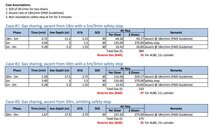I note that you've calculated that you need 110 b (1600 psi) to ascend safely from 30 m (100 ft) with an al80 (about 11 L). That seems very conservative to me. Maybe you have a very high air consumption rate?
Foxfish it is not about the pressure to get you home but rather the cubic footage. If I was doing this dive on double 100s, my min gas pressure would be 700 PSI, this was planed using the following criteria:
-Ascent rate of 30FPM
-A stressed SCR rate of 1 CFM for each diver
-Sharing gas on ascent
-One minute at depth to get on buddy's gas, solve immediate issues.
So now to walk you though the 3 of the profiles I posted for the deep 100' dive on an AL80
Profile one: stop at 50 for one minute and 15 for 3
So we need (for each diver)
1 minute of gas at 100
2 minutes of gas to go to 50
1 minute at 50
1 minute to get to 15
3 minutes at 15
.5 minute to go to the surface
Because we are sharing gas we need double the amount of breathable gas time we have. Because we are using a SCR of 1 for each diver just multiply gas time needed x ATA = CF needed to reach surface. Following?
2 minutes of gas at 4 ATA = 8 CF
4 minutes of gas at 3.27 ATA = 13 CF
2 minutes of gas at 2.51 ATA = 5 CF
2 minutes of gas at 1 ATA = 2 CF
6 minutes of gas at 1.5 ATA = 9 CF
1 minute of gas at 1.2 ATA = 1 CF
total= 38 CF, rounded up to 40 to make things easy.
That took about 60 seconds to do. If you wanted to make it even faster, take gas time needed X 1/2 max ATA... 17 minutes of gas *2.5 ATA = 42.5 CF... easy enough?
Now let's look at a GUE/UTD/DIR ascent. They use an ascent rate of 30FPM until half max depth, then 30 second stops every 10 feet from 1/2 max to the surface and spend 30 seconds moving in between stops.
2 minutes of gas at 4 ATA = 8 CF
4 minutes of gas at 3.27 ATA = 13 CF
2 minutes of gas at 2.51 ATA = 5 CF
2 minute of gas at 2.21 ATA 4.4 CF
2 minutes of gas at 1.9 ATA = 3.8 CF
2 minutes of gas at 1.6 ATA = 3.2 CF
2 minutes of gas at 1.3 ATA = 2.6 CF
total gas needed= 40 CF
Again took about 60 seconds to do. To make it even faster do the same as above, half max depth in ATA X gas time needed to surface = 40 CF
16 minutes * 2.5 ATA= 40 CF
Lets do a 3 minute stop at 15 feet and skip the deep stop this time..
.
2 minutes of gas at 4 ATA = 8 CF
6 minutes of gas at 2.76 ATA = 16.5 CF
6 minutes of gas at 1.5 ATA 9 CF
1 minute of gas at 1.2 ATA 1 CF
34.5 Round up to 35 CF needed for ascent.
Took about 45 seconds that time to calculate. We can also use the shortcut way again because 15 minutes X 2.5 ATA = 37 CF.
So now that we know how many cubic feet we need let's take a look at what pressure that is in different tanks. Different tanks have different tank factors. A tank factor is how many cubic feet there are in 100 PSI. Here is a basic chart
AL 80- 2.5
LP 85- 3
LP 95- 3.5
LP 104- 4
LP 120- 4.5
HP 100- 3
HP 120- 3.5
HP 130- 4
To calculate min gas pressure take CF/TF= min gas pressure x 100
So for an AL 80, our TF=2.5, We need 40CF for our chosen ascent profile. Therefore 40/2.5= 16 (x100) = 1600 PSI needed to ascend safely if SHTF.
If we were using HP130's for this same dive we'd use the following formula: 40/4= 10 (x100) = 1000 PSI needed to safely ascend.
Calculating min gas is very simple and really doesn't take that much time at all. I'd rather take the minute it takes to do and dive with a solid gas plan.





